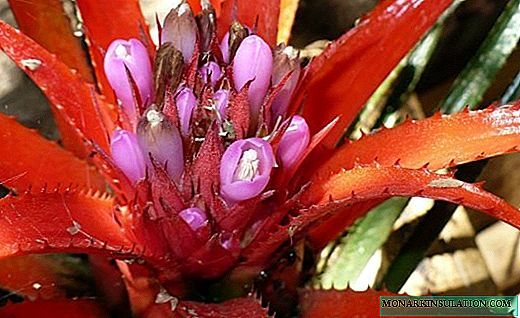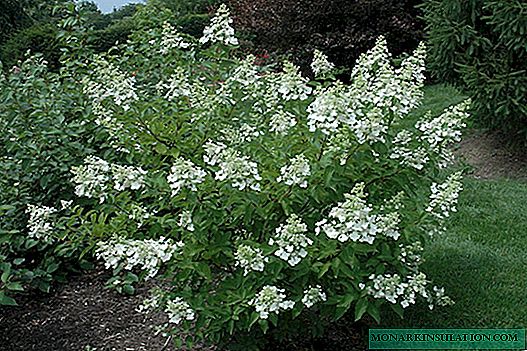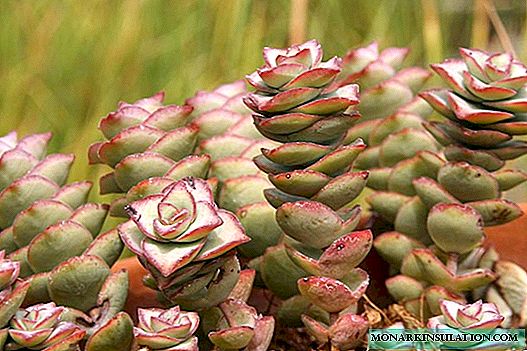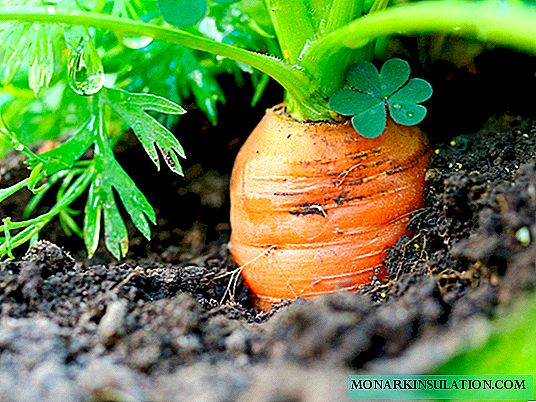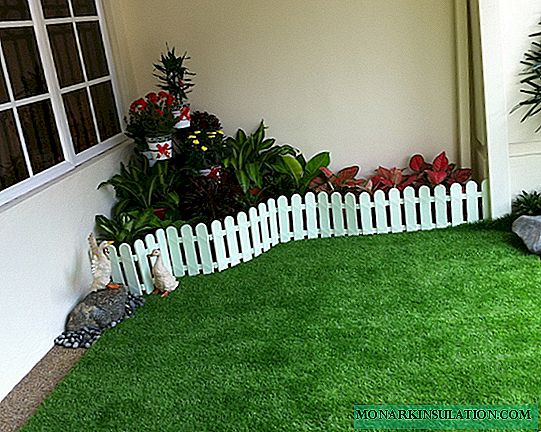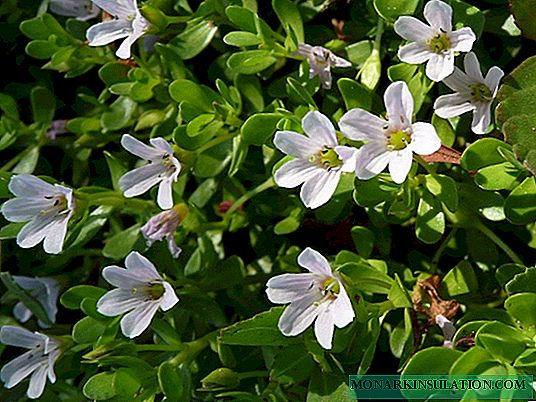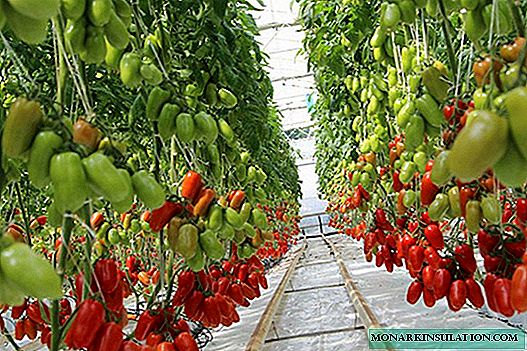
The variety of modern tomato varieties is amazing. In addition to a variety of colors, there are very original forms that can satisfy every lover of exotic. For example, tomato Kornabel, in the form of bell pepper, can perfectly decorate the beds.
Description of Kornabel tomato
Tomato Cornabel F1 is a hybrid breeding French specialists from Vilmorin. Although this tomato is grown in Russia, it is not yet included in the State Register. Some sources identify this tomato with the Dulce variety of the same originator. Keep in mind - these are completely different tomato hybrids.
Kornabel belongs to mid-season varieties - from the moment of planting seedlings to harvesting, 60 days pass (and from the moment of emergence of shoots 110-115 days). Suitable for cultivation both in open ground and in greenhouse conditions, so it can be grown throughout Russia.
Tomato Appearance
Hybrid Kornabel F1 refers to indeterminate (with continuous growth) tomatoes. This type of tomato is generative, that is, it has an increased ability to bear fruit and a weak ability to form stepsons. Powerful bushes with a developed root system have an open bush, due to which they are well ventilated.

Kornabel tomato is distinguished by powerful bushes
Fruits are tied with brushes of 7 pieces. Tomatoes have an elongated, pointed shape resembling bell pepper. The fruit sizes are quite large - length is up to 15 cm, average weight is 180-200 g (large specimens are found at 400-450 g each, and “dwarfs” at 70-80 g each at the end of the season). Ripe fruits have an even bright red color and a glossy surface.

Tomatoes are pepper-shaped and bright red in color.
The pulp is juicy and dense, characterized by a very good sweet taste. A distinctive feature is the high solids content.

The fruits are very fleshy, seed chambers occupy a small part of the fruit
Features of Tomato Cornabel
Hybrid Kornabel has several advantages:
- one-dimensionality of the fruit;
- long-term preservation of seed germination (5-6 years);
- extended fruiting period;
- excellent ability to tie fruit even in adverse weather conditions;
- good pulp density, providing high transportability;
- resistance to most tomato diseases (tobacco mosaic virus, verticillosis and fusariosis);
- excellent taste.
The disadvantages include the relative complexity of agricultural technology, as well as the high cost of seeds.
Given the huge number of varieties and hybrids of tomatoes, it is very difficult to compare Kornabel with other tomatoes.
Comparison of the Cornabel hybrid with some mid-season indeterminate tomatoes - table
| Grade name | Ripening days | Height cm | The mass of the fetus, g | Productivity | Features |
| Cornabel F1 | 110-115 | Up to 200 | 180-200 | 5-7 kg from 1 bush | Good ovary formation in bad weather conditions |
| 33 heroes | 110-115 | Up to 150 | 150-400 | Up to 10 kg from 1m2 | Drought tolerance |
| Concord F1 | 90-100 | Up to 150 | 210-230 | 5-6 kg from 1 bush | High resistance to TMV, verticillosis, fusariosis and cladosporiosis. |
| One hundred pounds | 110-115 | Up to 200 | 200-300 | Up to 10 kg from 1m2 | Particularly resistant to heat and humidity. |
| Charisma F1 | 115-118 | Up to 150 | 170 | Up to 7 kg from 1 bush | Resistance to temperature changes and diseases |
You can see that the characteristics of Kornabel F1 are very similar to other indeterminate varieties.
Comparison of tomatoes Grozdeva and Kornabel on video
How to Plant and Grow Cornabel Tomato
Since tomato is a hybrid, seeds need to be purchased annually. Cultivation is carried out in seedling method. Sowing of seeds begins 1.5-2 months before the intended transplantation to a permanent place. The usual sowing date is the end of February - mid-March (for greenhouse cultivation - early February).
It is necessary to calculate the sowing date so that the seedling transplant occurs before the flowering begins.
Seeds do not need additional processing. They are sown in soil prepared in advance and enriched with organic matter and minerals. You need to deepen the seeds by 2 cm.

Seeds are laid on moist soil and covered with 2 cm of soil
Before emergence, the seeded containers are kept in a dark place under a plastic film. Then the seedlings are taken out into a warm bright room and grown according to the same rules as other tomatoes. When two of these leaves are opened, seedlings are dived into separate cups with a volume of at least 0.5 liters.
Before transplanting to a permanent place, seedlings are hardened by removal to an open balcony or to the street. Planting seedlings in the soil can be carried out when the soil warms up to 15 aboutC to a depth of 10-12 cm (usually this occurs in May).
Care for tomato beds
The formation of tomatoes in 1 stalk - video
Frequent pinching can increase the incidence due to permanent injury to the bush.

Tall bushes must be attached to strong supports

Potassium compounds are very helpful in increasing the weight of the fruit, but if overused, they can be harmful.
- Artificially increasing the difference between night and day air temperatures. This measure is applied only for greenhouse cultivation by slightly heating the air at night. It is enough to increase the night temperature by a couple of degrees so that the bushes go to growth;
- shoot growth rates can be increased by increasing air humidity and rarer airing. In this case, evaporation of moisture by plants decreases, and growth is intensified. Only care must be taken - with increased humidity fungal diseases develop easily;
- frequent short-term irrigation also stimulate the growth of green mass;
- in greenhouse conditions, to increase the growth of shoots, you can still stop feeding plants with carbon dioxide, and add more nitrogen to the soil;
- in the process of forming the bush, several additional shoots should be left to increase green mass;
- to reduce generative growth, it is recommended to regulate the number of inflorescences: remove even the weakest buds before flowering;
- the weakening of light also contributes to a decrease in the number of ovaries and the growth of shoots. To reduce the amount of light, tomatoes shade from the south side. In greenhouses, special blinds are used for these purposes.
Over the years of growing tall tomatoes, I have developed some techniques for increasing productivity. When the first flowers appear, it is necessary to spray the bushes with a solution of boric acid (3 g per three-liter balloon). This will prevent flowers from shedding. I carefully remove the extra stepsons, and at the end of the summer I pinch the top of the stem above the last brush (I need to leave 2-3 leaves). If planting at the beginning of the fruiting period is fed with a salt solution (1 tablespoon of salt and potassium chloride per bucket of water) at the rate of 0.5 l per 1 bush, then the fruits will turn out to be sweeter. To do this, sprinkle the earth around the plants with ash. Top dressing also helps to get a tasty and plentiful crop. For the first feeding (15 days after planting in the ground) I use nitrofoska with urea (1 tablespoon per bucket of water), for the second (during flowering) - Solution or other complex fertilizer, and for the third (after another 15 days) - superphosphate (tablespoon in a bucket of water). When the weather begins to deteriorate, I add potassium sulfate to top dressing.
Harvesting and Harvesting
Cornbabel begins to harvest tomatoes in mid-July. Fruiting continues until mid-autumn. Usually sweet and juicy tomatoes are used to make salads. But various sauces from them are excellent. And the small last fruits from the autumn harvest are excellent for whole-fruit preservation.

Usually large and juicy Cornabel tomatoes are eaten fresh.
Reviews gardeners about the cultivar Kornabel
Kornabel is also good with me, though I just started to sing. Sowed March 8th. The hybrid is cool!
IRINA58
//forum.prihoz.ru/viewtopic.php?t=7403&start=1380
Cornabel tomatoes are really very good. Tasty, fleshy. I don’t have a greenhouse, so they grow well in the exhaust gas.
Nicky
//forum.tvoysad.ru/viewtopic.php?t=62152&start=900
I planted this variety for the first year (Kornabel). Pts ensued. large. There are clusters of identical tomatoes in the pictures. Not so with me. About the taste, not impressed. I will not plant anymore.
Lavandan
//forum.tvoysad.ru/viewtopic.php?t=62152&start=900
Hybrid Cornabel. Just a miracle tomato: both in taste and color, and especially in yield. Planted only two bushes, a favorite for planting next year.
Aleksan9ra
//forum.prihoz.ru/viewtopic.php?t=7403&start=1380
In my tomatoes, a dense white vein passes through the Kornabel fruit, and so does Sir Elian. Maybe that is not ripe? And so very productive, and Kornabel huge. Some fruits are similar to peppers.
Marina_M
//forum.prihoz.ru/viewtopic.php?t=7403&start=1380
Tomato Kornabel has excellent qualities and an unusual shape of the fruit. With little effort, you can get a decent harvest, even in adverse weather.

